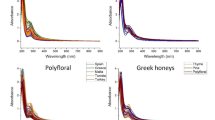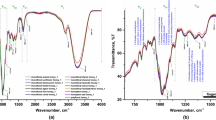Abstract
The present study aimed to identify adulteration of honey with sugar syrups and colorants using UV–Vis spectroscopy, combined with multivariate statistical analysis. A total of 209 honeys were used, including 151 commercial honey samples (thyme, pine, and polyfloral honeys) collected from different countries of Mediterranean (Greece, Malta, Spain, Tunisia, and Turkey) and 58 adulterated Greek thyme honey samples by adding syrups and colorants. Honey adulteration was identified using Principal Component Analysis (PCA) along with Random Forest (RF), Partial Least Squares – Discriminant Analysis (PLS-DA), and Data Driven-Soft Independent Modelling of Class Analogies (DD-SIMCA) using the spectral range of 220–550 nm. Comparatively, DD-SIMCA models produced better results in terms of accuracy and sensitivity in most cases evaluated. The results support the good predictive capability of UV–Vis spectroscopy combined with chemometrics for the determination of honey adulteration, and thus, it could be utilized as a rapid, inexpensive, and simple method.




Similar content being viewed by others
Data availability
The datasets generated and/or analyzed during the current study are available from the corresponding author on reasonable request.
References
Samarghandian S, Farkhondeh T, Samini F (2017) Honey and health: a review of recent clinical research. Pharmacogn Res 9(2):121. https://doi.org/10.4103/0974-8490.204647
EU Council Directive 2001/110/EC of 20 December 2001 relating to honey. Off J Eur Commun Legis 10:47–52 (2002) Available: https://eur-lex.europa.eu/legal-content/EN/TXT/PDF/?uri=CELEX:32001L0110&from=EN
Machado DeMelo AA, AlmeidaMuradian LBd, Sancho MT, PascualMaté A (2018) Composition and properties of Apis mellifera honey: a review. J Apic Res 57(1):5–37. https://doi.org/10.1080/00218839.2017.1338444
Pita-Calvo C, Vázquez M (2017) Differences between honeydew and blossom honeys: a review. Trends in Food Sci Technol 59:79–87. https://doi.org/10.1016/j.tifs.2016.11.015
Cengiz MF, Durak MZ (2019) Rapid detection of sucrose adulteration in honey using Fourier transform infrared spectroscopy. Spectrosc Lett 52(5):267–273. https://doi.org/10.1080/00387010.2019.1615957
Fakhlaei R, Selamat J, Khatib A, Razis AFA, Sukor R, Ahmad S, Babadi AA (2020) The toxic impact of honey adulteration: a review. Foods 9(11):1538
Wang J, Kliks MM, Jun S, Jackson M, Li QX (2010) Rapid analysis of glucose, fructose, sucrose, and maltose in honeys from different geographic regions using Fourier transform infrared spectroscopy and multivariate analysis. J Food Sci 75(2):C208–C214. https://doi.org/10.1111/j.1750-3841.2009.01504.x
Sivakesava S, Irudayaraj J (2001) Prediction of inverted cane sugar adulteration of honey by Fourier transform infrared spectroscopy. J Food Sci 66(7):972–978. https://doi.org/10.1111/j.1365-2621.2001.tb08221.x
Tewari J, Irudayaraj J (2004) Quantification of saccharides in multiple floral honeys using Fourier transform infrared microattenuated total reflectance spectroscopy. J Agric Food Chem 52(11):3237–3243. https://doi.org/10.1021/jf035176+
Kelly JD, Downey G, Fouratier V (2004) Initial study of honey adulteration by sugar solutions using midinfrared (MIR) spectroscopy and chemometrics. J Agric Food Chem 52(1):33–39. https://doi.org/10.1021/jf034985q
Siddiqui AJ, Musharraf SG, Choudhary MI, Rahman A-U (2017) Application of analytical methods in authentication and adulteration of honey. Food Chem 217:687–698. https://doi.org/10.1016/j.foodchem.2016.09.001
Das C, Chakraborty S, Acharya K, Bera NK, Chattopadhyay D, Karmakar A, Chattopadhyay S (2017) FT-MIR supported electrical impedance spectroscopy based study of sugar adulterated honeys from different floral origin. Talanta 171:327–334. https://doi.org/10.1016/j.talanta.2017.05.016
Huang F, Song H, Guo L, Guang P, Yang X, Li L, Zhao H, Yang M (2020) Detection of adulteration in Chinese honey using NIR and ATR-FTIR spectral data fusion. Spectrochim Acta A Mol Biomol Spectrosc 235:118297. https://doi.org/10.1016/j.saa.2020.118297
Riswahyuli Y, Rohman A, Setyabudi FMCS, Raharjo S (2020) Indonesian wild honey authenticity analysis using attenuated total reflectance-fourier transform infrared (ATR-FTIR) spectroscopy combined with multivariate statistical techniques. Heliyon 6(4):e03662. https://doi.org/10.1016/j.heliyon.2020.e03662
Se KW, Wahab RA, Syed Yaacob SN, Ghoshal SK (2019) Detection techniques for adulterants in honey: challenges and recent trends. J Food Compos Anal 80:16–32. https://doi.org/10.1016/j.jfca.2019.04.001
Beretta G, Granata P, Ferrero M, Orioli M, Maffei Facino R (2005) Standardization of antioxidant properties of honey by a combination of spectrophotometric/fluorimetric assays and chemometrics. Anal Chim Acta 533(2):185–191. https://doi.org/10.1016/j.aca.2004.11.010
Gan Z, Yang Y, Li J, Wen X, Zhu M, Jiang Y, Ni Y (2016) Using sensor and spectral analysis to classify botanical origin and determine adulteration of raw honey. J Food Eng 178:151–158. https://doi.org/10.1016/j.jfoodeng.2016.01.016
Wang S, Guo Q, Wang L, Lin L, Shi H, Cao H, Cao B (2015) Detection of honey adulteration with starch syrup by high performance liquid chromatography. Food Chem 172:669–674. https://doi.org/10.1016/j.foodchem.2014.09.044
Yilmaz MT, Tatlisu NB, Toker OS, Karaman S, Dertli E, Sagdic O, Arici M (2014) Steady, dynamic and creep rheological analysis as a novel approach to detect honey adulteration by fructose and saccharose syrups: correlations with HPLC-RID results. Food Res Int 64:634–646. https://doi.org/10.1016/j.foodres.2014.07.009
Ruiz-Matute AI, Soria AC, Martínez-Castro I, Sanz ML (2007) A new methodology based on GC−MS to detect honey adulteration with commercial syrups. J Agric Food Chem 55(18):7264–7269. https://doi.org/10.1021/jf070559j
Bertelli D, Lolli M, Papotti G, Bortolotti L, Serra G, Plessi M (2010) Detection of honey adulteration by sugar syrups using one-dimensional and two-dimensional high-resolution nuclear magnetic resonance. J Agric Food Chem 58(15):8495–8501. https://doi.org/10.1021/jf101460t
Rachineni K, Rao Kakita VM, Awasthi NP, Shirke VS, Hosur RV, Chandra Shukla S (2022) Identifying type of sugar adulterants in honey: combined application of NMR spectroscopy and supervised machine learning classification. Curr Res Nutr Food Sci 5:272–277. https://doi.org/10.1016/j.crfs.2022.01.008
Padovan GJ, De Jong D, Rodrigues L, Marchini JS (2003) Detection of adulteration of commercial honey samples by the 13C/12C isotopic ratio. Food Chem 82(4):633–636. https://doi.org/10.1016/S0308-8146(02)00504-6
Tosun M (2013) Detection of adulteration in honey samples added various sugar syrups with 13C/12C isotope ratio analysis method. Food Chem 138(2):1629–1632. https://doi.org/10.1016/j.foodchem.2012.11.068
Başar B, Özdemir D (2018) Determination of honey adulteration with beet sugar and corn syrup using infrared spectroscopy and genetic-algorithm-based multivariate calibration. J Sci Food Agric 98(15):5616–5624. https://doi.org/10.1002/jsfa.9105
Li Q, Zeng J, Lin L, Zhang J, Zhu J, Yao L, Wang S, Yao Z, Wu Z (2020) Low risk of category misdiagnosis of rice syrup adulteration in three botanical origin honey by ATR-FTIR and general model. Food Chem 332:127356. https://doi.org/10.1016/j.foodchem.2020.127356
Bázár G, Romvári R, Szabó A, Somogyi T, Éles V, Tsenkova R (2016) NIR detection of honey adulteration reveals differences in water spectral pattern. Food Chem 194:873–880. https://doi.org/10.1016/j.foodchem.2015.08.092
Guelpa A, Marini F, du Plessis A, Slabbert R, Manley M (2017) Verification of authenticity and fraud detection in South African honey using NIR spectroscopy. Food Control 73:1388–1396. https://doi.org/10.1016/j.foodcont.2016.11.002
Oroian M, Ropciuc S, Paduret S (2018) Honey adulteration detection using Raman spectroscopy. Food Anal Methods 11(4):959–968. https://doi.org/10.1007/s12161-017-1072-2
Rios-Corripio MA, Rios-Leal E, Rojas-López M, Delgado-Macuil R (2011) FTIR characterization of Mexican honey and its adulteration with sugar syrups by using chemometric methods. J Phys Conf Ser 274:012098. https://doi.org/10.1088/1742-6596/274/1/012098
Wu X, Xu B, Ma R, Niu Y, Gao S, Liu H, Zhang Y (2022) Identification and quantification of adulterated honey by Raman spectroscopy combined with convolutional neural network and chemometrics. Spectrochim Acta A Mol Biomol Spectrosc 274:121133. https://doi.org/10.1016/j.saa.2022.121133
Chen Q, Qi S, Li H, Han X, Ouyang Q, Zhao J (2014) Determination of rice syrup adulterant concentration in honey using three-dimensional fluorescence spectra and multivariate calibrations. Spectrochim Acta A Mol Biomol Spectrosc 131:177–182. https://doi.org/10.1016/j.saa.2014.04.071
Yan S, Sun M, Wang X, Shan J, Xue X (2022) A novel, rapid screening technique for sugar syrup adulteration in honey using fluorescence spectroscopy. Foods 11(15):2316. https://doi.org/10.3390/foods11152316
Ansari MJ, Al-Ghamdi A, Khan KA, Adgaba N, El-Ahmady SH, Gad HA, Roshan A, Meo SA, Kolyali S (2018) Validation of botanical origins and geographical sources of some Saudi honeys using ultraviolet spectroscopy and chemometric analysis. Saudi J Biol Sci 25(2):377–382. https://doi.org/10.1016/j.sjbs.2017.09.005
Nunes A, Zilto Azevedo G, dos Rocha Santos B, Vanz Borges C, Pace Pereira Lima G, Conte Crocoli L, Moura S, Maraschin M (2022) Characterization of Brazilian floral honey produced in the states of Santa Catarina and São Paulo through UltraViolet–Visible (UV–Vis), near-infrared (NIR), and nuclear magnetic resonance (NMR) spectroscopy. Food Res Int 162:111913. https://doi.org/10.1016/j.foodres.2022.111913
Orfanakis E, Markoulidakis M, Philippidis A, Zoumi A, Velegrakis M (2021) Optical spectroscopy methods combined with multivariate statistical analysis for the classification of cretan thyme, multi-floral and honeydew honey. J Sci Food Agric 101(13):5337–5347. https://doi.org/10.1002/jsfa.11182
Roshan A-RA, Gad HA, El-Ahmady SH, Khanbash MS, Abou-Shoer MI, Al-Azizi MM (2013) Authentication of monofloral Yemeni sidr honey using ultraviolet spectroscopy and chemometric analysis. J Agric Food Chem 61(32):7722–7729. https://doi.org/10.1021/jf402280y
Suhandy D, Yulia M (2021) The use of UV spectroscopy and SIMCA for the authentication of indonesian honeys according to botanical, entomological and geographical origins. Molecules 26(4):915. https://doi.org/10.3390/molecules26040915
de Souza RR, de Sousa Fernandes DD, Diniz PHGD (2021) Honey authentication in terms of its adulteration with sugar syrups using UV–Vis spectroscopy and one-class classifiers. Food Chem 365:130467. https://doi.org/10.1016/j.foodchem.2021.130467
Suhandy D, Kusumiyati Kuncoro S, Rahmawati W, Yulia M (2022) Authentication of pure and adulterated Sumbawa monofloral honey using ultraviolet-visible spectroscopy. IOP Conference Series: Earth and Environmental Science, 1027(1): 012014. doi: https://doi.org/10.1088/1755-1315/1027/1/012014
Mitra PK, Karmakar R, Nandi R, Gupta S (2023) Low-cost rapid workflow for honey adulteration detection by UV–Vis spectroscopy in combination with factorial design, response surface methodology and supervised machine learning classifiers. Bioresour Technol Rep 21:101327. https://doi.org/10.1016/j.biteb.2022.101327
Valinger D, Longin L, Grbeš F, Benković M, Jurina T, Kljusurić JG, Tušek AJ (2021) Detection of honey adulteration–the potential of UV-Vis and NIR spectroscopy coupled with multivariate analysis. LWT 145:111316. https://doi.org/10.1016/j.lwt.2021.111316
Breiman L (2001) Random forests. Mach Learn 45(1):5–32. https://doi.org/10.1023/A:1010933404324
Barker M, Rayens W (2003) Partial least squares for discrimination. J Chemom A J Chemom Soc 17(3):166–173. https://doi.org/10.1002/cem.785
Rodionova OY, Titova AV, Pomerantsev AL (2016) Discriminant analysis is an inappropriate method of authentication. TrAC Trends Anal Chem 78:17–22. https://doi.org/10.1016/j.trac.2016.01.010
Rodionova OY, Pomerantsev AL (2020) Chemometric tools for food fraud detection: the role of target class in non-targeted analysis. Food chem 317:126448. https://doi.org/10.1016/j.foodchem.2020.126448
Pedregosa F, Varoquaux G, Gramfort A, Michel V, Thirion B, Grisel O, Blondel M et al (2011) Scikit-learn: machine learning in Python. J Mach Learn Res 12:2825–2830. https://doi.org/10.48550/arXiv.1201.0490
Parri E, Santinami G, Domenici V (2020) Front-face fluorescence of honey of different botanic origin: a case study from Tuscany (Italy). Appl Sci 10(5):1776. https://doi.org/10.3390/app10051776
Guellis C, Valério DC, Bessegato GG, Boroski M, Dragunski JC, Lindino CA (2020) Non-targeted method to detect honey adulteration: combination of electrochemical and spectrophotometric responses with principal component analysis. J Food Compos Anal 89:103466. https://doi.org/10.1016/j.jfca.2020.103466
Dimakopoulou-Papazoglou D, Ploskas N, Koutsoumanis K, Katsanidis E. Identification of geographical and botanical origin of Mediterranean honeys using UV-vis spectroscopy and multivariate statistical analysis. (Under review)
Acknowledgements
This paper is part of the PRIMA programme, supported by European Union’s Horizon 2020 research and innovation programme, under grant agreement No 1932, project MEDIFIT (Call 2019 Section "Introduction" Agrofood IA).
Funding
This study was supported by Horizon Europe, No 1932.
Author information
Authors and Affiliations
Contributions
Investigation: DDP; Formal analysis: DDP, NP, EK; Methodology: DDP, CSS, SS, EK; Resources: DDP, CSS, SS, EK, KK, VV; Writing—original draft preparation: DDP; Writing—review and editing: EK, NP, KK, SS, CSS, VV; Funding acquisition: KK; Project administration: EK, KK, VV; Supervision: EK.
Corresponding author
Ethics declarations
Conflict of interest
The authors declare no conflict of interest.
Compliance with ethics requirements
This article does not contain any studies with human participants or animals performed by any of the authors.
Additional information
Publisher's Note
Springer Nature remains neutral with regard to jurisdictional claims in published maps and institutional affiliations.
Rights and permissions
Springer Nature or its licensor (e.g. a society or other partner) holds exclusive rights to this article under a publishing agreement with the author(s) or other rightsholder(s); author self-archiving of the accepted manuscript version of this article is solely governed by the terms of such publishing agreement and applicable law.
About this article
Cite this article
Dimakopoulou-Papazoglou, D., Ploskas, N., Serrano, S. et al. Application of UV–Vis spectroscopy for the detection of adulteration in Mediterranean honeys. Eur Food Res Technol 249, 3043–3053 (2023). https://doi.org/10.1007/s00217-023-04347-1
Received:
Revised:
Accepted:
Published:
Issue Date:
DOI: https://doi.org/10.1007/s00217-023-04347-1




